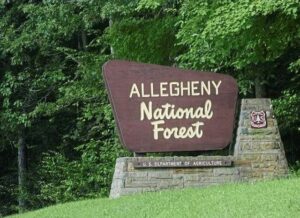Things to Do in The LHR / Attractions, Things to Do in The LHR / State Forests
Things to Do in The LHR / Attractions, Things to Do in The LHR / State Forests
Discover the Allegheny National Forest
Nestled in Northwestern Pennsylvania, approximately 100 miles northeast of Pittsburgh, the Allegheny National Forest spans an impressive 513,175 acres. This vast expanse of natural beauty is home to the Kinzua Dam, which impounds the Allegheny River to create the breathtaking Allegheny Reservoir. The forest’s administrative headquarters are located in Warren, with ranger stations in Marienville and Bradford.

Before European settlement, the Allegheny Plateau was dominated by Eastern Hemlock and American Beech, with species like sugar maple, birch, chestnut, and white pine adding to the forest’s biodiversity. Large trees, fallen logs, and a multi-layered canopy defined this old-growth forest, supporting a diverse ecosystem with naturally regulated deer populations.
Native Ameri
cans managed parts of the forest through controlled burns to enhance berry production and ease travel. However, the landscape changed dramatically with the arrival of European settlers in the early 19th century, who cleared land for agriculture and timber.
The demand for lumber skyrocketed as the U.S. expanded westward. Technological advancements like steam-powered sawmills and railroads allowed for the mass harvesting of timber. Tanneries utilizing hemlock bark flourished, while industries such as wood chemical production further depleted the forest.
By the early 1900s, over-logging left barren hillsides, leading to environmental challenges like soil erosion, floods, and wildfires. The abandoned lands were later acquired by the federal government through the Weeks Act of 1911, which led to the official establishment of the Allegheny National Forest in 1923.
Under the management of the U.S. Forest Service, the Allegheny National Forest underwent a significant transformation. The once-barren landscape gave way to thriving hardwood forests dominated by black cherry, red maple, and sugar maple. Sustainable forest management practices, such as even-aged management and selective harvesting, have ensured the continued health of
the forest ecosystem.
In response to environmental concerns, legislation such as the Multiple-Use Sustained-Yield Act of 1960 introduced conservation efforts aimed at balancing timber production with recreation, wildlife preservation, and watershed protection.
The Allegheny National Forest offers a wealth of outdoor recreation opportunities, from hiking along the scenic Minister Creek Trail to boating on the expansive Allegheny Reservoir. Campgrounds, picnic areas, and accessible facilities provide a welcoming environment for visitors.
Wildlife enthusiasts can explore designated areas like Buzzard Swamp and Little Drummer, where diverse flora and fauna thrive. Additionally, the Hickory Creek Wilderness Area and Allegheny Islands Wilderness Area, designated in 1984, offer pristine landscapes for backcountry exploration.
Today, the Allegheny National Forest remains a testament to the balance between human use and natural preservation. Managed for timber, recreation, and ecological health, it continues to provide benefits for present and future generations.
Plan your visit today and experience the beauty and history of the Allegheny National Forest!
© 2025 Lumber Heritage Region LLC | Website Designed & Hosted by Pixel & Hammer